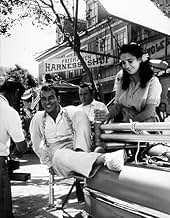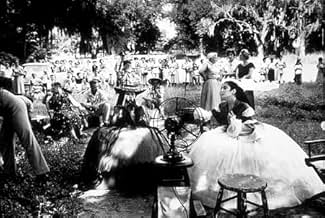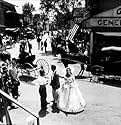अपनी भाषा में प्लॉट जोड़ेंA student falls in love with a Southern belle, but their relationship is complicated by her troubled past and the onset of the Civil War.A student falls in love with a Southern belle, but their relationship is complicated by her troubled past and the onset of the Civil War.A student falls in love with a Southern belle, but their relationship is complicated by her troubled past and the onset of the Civil War.
- निर्देशक
- लेखक
- स्टार
- 4 ऑस्कर के लिए नामांकित
- 1 जीत और कुल 8 नामांकन
- Townsman
- (बिना क्रेडिट के)
- Parthenia
- (बिना क्रेडिट के)
- Townsman
- (बिना क्रेडिट के)
- Jake - Bartender
- (बिना क्रेडिट के)
- Spectator
- (बिना क्रेडिट के)
फ़ीचर्ड समीक्षाएं
Clearly, MGM was hoping for something approaching "Gone with the Wind" - and, they failed. However, "Raintree County" is not so bad, when viewed without the comparative eye. The big budget production values are beautiful; the obvious expense, and the cast, helps maintain interest in the relatively weak storyline. And, it does get better, as the starring triad (Clift, Taylor, and Saint) slowly draw you into their lives. Viewing will require some degree of commitment, though; it's a long movie.
Early in the filming, Clift left a visit with friends at Taylor's home, and drove his car into a telephone pole. He nearly died, and his facial "reconstruction" is obvious throughout most of "Raintree County". Clift's performance is uneven, also - but, he was too good an actor to be completely derailed. And, Clift is better than you might have heard. Also, he, does not look as bad as many have claimed. The eventual toll on his "looks" was mainly taken by a growing dependence on alcohol and painkillers.
Taylor, who is credited with saving Clift's life, shows some of the sparkle that would quickly make her one of the best actresses in the business, especially during the film's second half. Nigel Patrick, Lee Marvin, Rod Taylor, and Agnes Moorehead head up a strong supporting cast. Robert Surtees' savory cinematography is noteworthy. And, Nat King Cole sings the Johnny Green title song, a minor hit, very sweetly.
****** Raintree County (10/4/57) Edward Dmytryk ~ Montgomery Clift, Elizabeth Taylor, Eva Marie Saint
I saw "Raintree County" when I was 15. Orphaned at six, I'd just departed from an orphans home in Dallas, after nearly nine years. Knowing virtually nothing of the outside world, I was receptive to everything, every person that I encountered. That summer of 1958, I sneaked into the Forest Park Drive-In to see Elizabeth Taylor, of whom I knew little, other than that she was a breath-taking beauty, and had been recently widowed when Michael Todd's chartered plane had crashed.
The characters in the movie (when I was 15) were literal, if not visceral: the magnificence of Miss Taylor's satin gowns encased over crinoline, Lee Marvin's sharp, smart-alecky wit, the professor's lechery, Montgomery Clift's Yankee stoicism, Agnes Moorehead's curious detachment, were all primary colors.
Forty-five years have passed. Those primary colors are now a multitude of blendings and shadings of secondary colors. Montgomery Clift's character is now a beautifully controlled young man who reflects his parents' stoicism, a young man whose intelligence and self control are at the core of the film, and upon whom all characters revolve.
Originally, I thought that "Raintree County" was strictly Taylor's vehicle. She is the burr under the saddle, the exquisite seductress that interfers with Clift's heretofore regulated, almost predestined lifestyle upon his college graduation.
'Raintree' is an achingly beautiful film, and Miss Taylor, who is the most gifted in her portrayal of anguished characters, blesses the movie. Norma Shearer could be beautiful in 'Marie Antoinette", but she lacked depth. Betty Davis portrayed Sturm und Drang, but was never a clothes horse. Taylor combines the two.
Having read some of the other's comments, most of whom disliked the story, perhaps it helps to be Southern to truly love this film. And also, one wants to realize that it depicts two diametrically opposed cultures: North and South. When Northern chill mixes with Southern humidity, chaos results. And so it did, and it was known as The War Between the States.
In conclusion, one wants to luxuriate in this film: Lockridge wrote a brilliant story, and for the most part, it is well delivered. It is rich in history and characterization.
Elizabeth Taylor is about the only central player who emerges relatively unscathed and her Academy Award nomination was deserved (and certainly more worthy of the Oscar she did win for "BUtterfield 8".)
I bought reserved seat tickets for this before its initial engagement began and the reviewers' generally negative appraisals were available. M-G-M's new big screen process, MGM Camera 65 ("Window of the World" as they termed it, used only once again by the studio for "Ben-Hur"), afforded a handsome showcasing of all the expense lavished upon this production, but, even as a teenager, I squirmed in my seat as its oh-so-lengthy reels unspooled and I left the theater regretting that its makers hadn't somehow achieved something memorable for its quality and dramatic impact, rather than for its longueurs. Johnny Green's score (and Nat King Cole's rendition of the title song) did sound awfully good over the stereophonic sound system at that Beverly Hills, California theater and that's one aspect of this disappointment that is now probably lost forever.
But dark Elizabeth is Veronica to Saint's blond Betty. Or is it the other way around? No matter. Anyway they have contrasting personalities: the intensely passionate Taylor and the winsome and innocent Saint. Saint, for instance, would never dream of putting out for handsome, intelligent, and sensitive Monty, whereas Taylor does so on their second or third date and then LIES to him about having gotten pregnant. He doesn't mind one way or the other, besotted as he is.
I don't know whether it's worthwhile trying to get through the plot. It's probably been done elsewhere, and I'm too tired to trace the trips, the outbursts of anger and guilt, Sherman's march through Georgia, and the finale, which no power on earth could force me to reveal. Much of it has to do with the fear of having a touch of the tar brush in one's blood.
But I must say, New Orleans is given rather a bad rap as a representative Southern city. It wasn't like any of the others. It had an animated and rich multi-ethnic heritage at the time -- American, French, Spanish, Caribbean, and African. Edgar Degas visited French relatives there late in the '19th century. Slaves of course but not nearly as brutal a system as elsewhere. William Tecumseh Sherman taught at Louisiana State Seminary of Learning & Military Academy, later to become Louisiana State University.
Others have claimed that it was easy to tell the difference between pre- and post-accident scenes of Montgomery Clift but I couldn't. As for the accident, Clift was doing booze and other substances to excess on a daily basis during the shooting. I mean, eating steaks he'd spilled on the floor and so on. After an evening at Liz Taylor's manse perched on a hill, he drove drunkenly down the winding road and didn't quite make it.
Neither the accident nor the booze seemed to interfere with his acting, although the part of the pathetic loner in "A Place in the Sun" suited him better than the idealist he's forced to portray here. Elizabeth Taylor is blindingly beautiful. Many of her films cast her has a frustrated nut job. Eva Marie Saint has the more sympathetic role as the unspectacular girl from home who never manages to shrug off her love for Clift.
It's long. It has an overture and even an entr'acte, evocative photography by Robert Surtees, and a lushly orchestrated but fulsome score by Johnny Green. It's no "Gone With the Wind," though, partly because it substitutes anguish for laughs.
Raintree had two insurmountable problems: ham-handed direction and a clumsy, uninspired script that failed to flesh out the characters of several cast members including two leading players. Worst impacted was Monty Clift as Johnny Shawnessy, a role so bland that it offered the actor nothing to grab hold of. Johnny is simply a nice person, honorable, loyal, patient, and truthful. He is someone of good values, a person to rely on, occasionally funny in an adolescent sort of way, and a good son to his boring two-dimensional parents. (Correction. Agnes Moorhead as Johnny's mother is one dimensional. The script's fault, not hers.) In short, there's nothing interesting about Johnny. He's ordinary. Apparently, studio executives didn't see a problem with this, even though Johnny Shawnessy is continuously front and center in a film that originally ran for almost three hours, as it does again in the restored video version.
Clift, one of the most gifted American film actors of the twentieth century, knew he was prostituting himself by appearing in Raintree. He responded by delivering what is arguably the worst performance of his career. It's painful to watch him: in most of his scenes he appears pallid, slightly dwarfish, and insignificant, giving the impression that he was privately making believe he really wasn't in the film at all.
The first excruciating hour of the picture is almost enough to drive audiences out of the theater. Since GWTW was long, Raintree County is long--and unfocused. In one particularly vapid scene Monty and Eva Marie Saint linger amid the widescreen splendor of well-scouted, photographically appropriate locations. As the two exchange graduation presents with Laurel and Hardy-like formality, the script calls for Eva Marie to coyly break into girlish giggles and say things like `Isn't that niiieeccce?...We think the same things. Isn't that crazy? Tee-hee-hee-hee-hee.' Privately, Eva Marie must have been wondering what crime she might have committed to have caused fate to whirl her from the triumph of her 1954 performance in On the Waterfront to this swampy mess.
The film is equally inept in making use of Lee Marvin, who was reduced to doing his loutish, clumsy, I'm-so-dumb schtick. Marvin wasn't nearly as good at broad physical comedy as he and some others seemed to think he was. (Doing more subtle comedy, however, where less is more, was another thing altogether for Marvin. Watch him as a clueless wannabe in a wonderful film like Pocket Money to see what he can do with a great comic role.) We watch as Lee challenges Monty first to a race (lots of grotesquely exaggerated, manly calisthenics at the starting line), then to see who can out-drink the other, while a dozen equally buffoonish male extras shout and yell on cue. Johnny, a guileless innocent, gets thoroughly looped for the first time in his life, whoops it up, and executes a flying swan dive into a bunch of liquor barrels. (In real life, Monty was a little less innocent than Johnny Shawnessy; according to his biographers, he was a walking all-nite pharmacy of illicit substances.)
To give credit where it's due, the film is briefly buoyed by the presence of the wonderful Nigel Patrick as a roguish schoolmaster with an eye for other men's wives. Happily for us, Patrick steals all of his scenes, impatiently bellowing at or comically insulting his young charges and generally pumping some desperately needed fire and energy into the film.
After a very long time, something of major interest finally occurs: Elizabeth Taylor makes her entrance. Sexy, conniving, dark-eyed Liz steals Johnny away from poor, decent Eva Marie and soon hornswoggles him into marrying her by falsely claiming to be pregnant. While on their honeymoon aboard a paddlewheeler, she nonchalantly arranges a dozen dolls on their bed and shows Monty her all-time favorite, a hideous half-white, half-black doll, appearing burnt in a fire and looking like it was designed by Bela Lugosi. This creepy figurine seemingly makes no impression on Monty, even as members of the audience are rearing back in horror, crossing themselves, and yelling `Monty! Watch out!!'
Taylor delivers a solid performance that displays the rising talent that she had already shown a few years before in A Place in the Sun and which would later would come to fruition in such films as Who's Afraid of Virginia Wolf and Giant. As Susanna Drake, she is initially sexually beguiling towards Johnny. Then, after they marry, she begins to show the first signs of the madness within her. As the atmosphere around her grows slowly darker, you find yourself surprised to realize you're at last being drawn into the story. The actress took a gamble with this unsympathetic role, that of a southern-born woman who fails to see anything wrong with owning slaves and is terrified of possibly finding that she might have a single drop of `negra' blood in her veins. At the same time she manages to elicit a measure of sympathy for this narrow and unbalanced woman by displaying a touching vulnerability simultaneously with her fear of what's happening to her mind.
If anyone triumphs in this upholstered turkey, it's Liz Taylor, always a born survivor.
क्या आपको पता है
- ट्रिवियाThe scenes which Montgomery Clift shot for this movie just before his accident represent the only color footage available of him before he was disfigured. All of his previous movies had been shot in black-and-white.
- गूफ़After Abraham Lincoln's 1860 election, the crowd sings "The Battle Hymn of the Republic". However, Julia Ward Howe wrote the poem on which the song was based for the Atlantic Monthly in 1861.
- भाव
Susanna Drake: That 4th of July race... what happens when you win?
John Wickliff Shawnessy: Well, according to a friend of mine, if I win, a beautiful girl will place a garland of oak leaves on my sun-colored locks.
Susanna Drake: I'd like to be that girl.
John Wickliff Shawnessy: Maybe it can be arranged?
Susanna Drake: Oh, it can be arranged, all right. *I'll* arrange it.
- इसके अलावा अन्य वर्जनThe longer Roadshow version was released on VHS by Warner, where it was labeled as Reconstructed Original Version. It has also been shown on Turner Classic Movies cable channel. This version contains nearly 15 minutes of additional material not found on the General Release Version.
- कनेक्शनEdited from गॉन विथ द विंड (1939)
- साउंडट्रैकRaintree County
Music by Johnny Green (uncredited)
Lyrics by Paul Francis Webster
Sung by Nat 'King' Cole
टॉप पसंद
विवरण
बॉक्स ऑफ़िस
- बजट
- $50,00,000(अनुमानित)
- दुनिया भर में सकल
- $6,543
- चलने की अवधि3 घंटे 2 मिनट
इस पेज में योगदान दें





































